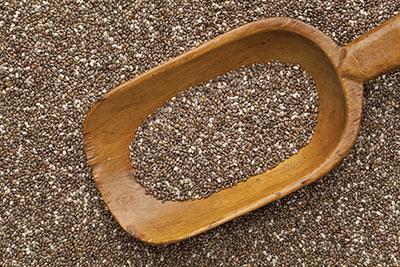
The Final Proof: May 2013
May 2, 2013
By Jane Dummer RD
Chia seeds were introduced to me during my childhood; not as a part of my breakfast, but in the form of the Chia Pet.
Chia seeds were introduced to me during my childhood; not as a part of my breakfast, but in the form of the Chia Pet. The seeds used for Chia Pets are actually edible, and chia seeds are experiencing a popularity surge in both the Canadian and American marketplaces. They are an ancient food that the Aztecs consumed for many years. They belong to the mint family and were originally harvested and continue to grow in Mexico, South and Central America.
 |
|
| Chia seeds gained popularity through the Chia Pet, but they are full of nutritional value.
|
Today, chia seeds are grown in Australia, which has become the leading producer. Like quinoa, chia seeds are tiny.
They have a mild, nutty flavour, are very versatile, and offer a gluten-free nutritional punch.
When I was researching this column I discovered how salba fits into the chia landscape. Both chia and salba are varieties of the Salvia hispanica plant. The first difference is that most chia seeds are black and salba is white. Dr. Vladimir Vuksan, from the departments of medicine and nutritional sciences, faculty of medicine at the University of Toronto, has researched the effects of salba on human health for more than 13 years. Vuksan’s research has shown salba may decrease certain risks for cardiovascular disease in type 2 diabetics. “There are many different varieties of chia. Similar to any other crop, the variety and growing conditions influence the nutritional qualities,” he explains. “The growing of salba as a single variety is highly regulated, producing a repeatable nutritional profile, whereas many varieties of chia can grow wild, resulting in inconsistent nutritional compositions.”
So what does this mean when it comes to nutritional content? Chia seeds will have varying amounts of linoleic acid or ALA (an essential omega-3 fatty acid), fibre (both soluble and insoluble), protein, antioxidants, vitamins and minerals. Salba’s nutrient profile is consistent and repeatable; therefore this variety is best used when studying specific effects on human health. ALA can help decrease inflammation in the body. Although the studies have mixed findings about the exact mechanism at work, ALA does offer a heart health benefit. Focusing on the soluble fibre, salba has an extremely high amount of viscous fibre activity for seed. When I think viscous fibre, both oats and barley come to mind, not salba or chia. However, the viscosity is an important factor to consider when using salba and chia as ingredients in a recipe.
Besides tasting great, chia seeds have become a recent marketing trend, making them a very popular, healthy ingredient for baked goods. Andrew Gunn, the product development manager of COBS Bread (BD Canada Ltd) in Vancouver, says the company uses chia seeds in 11 of its bread products, ranging from loaves and buns to a fruit loaf and log. “We use anywhere from seven to 15 per cent in the recipes,” Gunn says of the process of using chia seeds. “We bake using whole chia seeds, which means the flavour does not change. There is a change in texture, but it is only slight. The actual functionalities of the dough do not change at all, providing you add the seeds at the correct stage of mixing. The final product retains a lot more moisture throughout the baking process, which results in a slightly increased shelf life.” The only caution Gunn has for other bakers: “You need to be careful about how the seeds absorb water.”
From the Chia Pet to the tiny, fashionable seed with a big nutritional impact, this is one more food we can add to our daily diet to improve health. Do you use chia seeds in your favourite recipes? If not, experiment by adding them to your baked goods and breads.
Recipe Link
Coconut and Almond Flour Muffins with Macadamia Nuts (Gluten-free) by Celebrity Chef Kate McAloon, www.thechiaco.com.au/chia_recipes/Bake%20with%20Chia .
Jane Dummer, RD, is a leading dietitian for the Canadian food and nutrition industry. Jane offers services specializing in agri-food, functional foods and food safety. For more information, visit www.janedummer.com .
Print this page
Leave a Reply